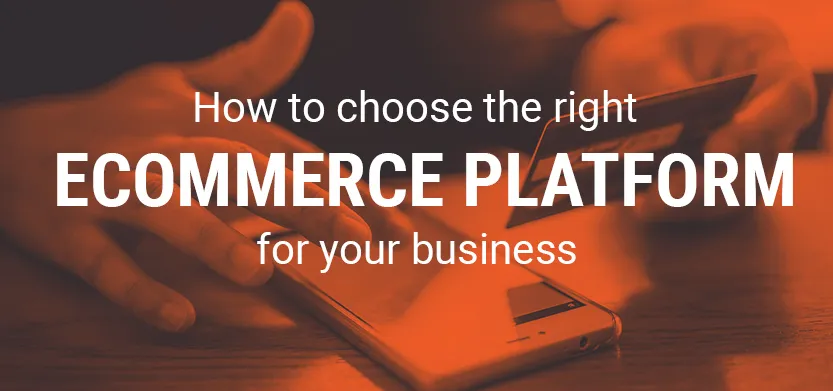How to choose the right ecommerce platform for your business
If your ecommerce business is growing beyond your website’s capabilities, it may be time to take a fresh look at your business ecommerce platform: the core software that supports your pages, your data and your access to that data.
But wading through the vast amount of platform options — and advice about which one is best — can be a daunting task for even the most seasoned ecommerce teams. With that in mind, we’ve broken down the top priorities to keep in mind when determining the best ecommerce platform for your business.
Areas to consider when picking the right ecomm platform for growth
- Open Source vs. SaaS ecommerce platforms: Open source platforms are free to use and can be modified as needed. SaaS platforms are owned by one company, which you lease on a monthly or annual basis.
- Ecommerce API and features checklist: Develop a checklist of the features your business needs (ideally both now, and in the foreseeable future and make sure that the platform can accommodate them.
- The pros and cons of SaaS: Easy to adopt, quick set up, low introductory rates. Little control over the functionality of your site, as the code is owned by another company, and customization can be a costly endeavour.
- The pros and cons of open source ecommerce platforms: Free to use and you can modify to your specific needs but will require extensive coding expertise.
- The pros and cons of hybrid platforms: Ideally, you can take the elements from both SaaS and Open Source platforms. The trick is to avoid making your platform a mess of modules, so planning with an ecommerce consultant is your best bet.
Open Source vs SaaS Ecommerce Platforms
Boxed solutions in ecommerce are practically unheard of today. So, all the platforms available are typically divided into three categories: open source, SaaS (Software as a Service) and hybrids.
Open source platforms are free to use and can be modified as needed. These include WordPress, Drupal and Joomla. SaaS platforms are owned by one company, which you lease on a monthly or annual basis. These include Squarespace and Shopify.
The choice you make between open source and SaaS won’t just affect your monthly costs, it will either enable you, or limit you, in your choice of features.
Ecommerce API and Features Checklist
Regardless of which platforms may be on your shortlist of candidates, you should develop a checklist of the features your business needs (ideally both now, and in the foreseeable future as your company scales) and ensure that your platform can accommodate them. These features should either be included in the base platform or be available as ecommerce APIs that you can add if and when you need them. Below are a few of the most important features to keep in mind.

- Scalability: As your business continues to grow, you’ll certainly be getting more customers, and probably have more product SKUs to track. If your platform can’t grow with you, the time and money you invest in a platform today will be wasted.
- Speed: In the world of ecommerce, every second counts. If your platform lags, customers will find a faster place to shop. It’s important not to bog your ecommerce business down with features you don’t want or need.
- Customizable design: Does the platform offer templates you can customize as needed, or are you limited to a small number of cookie-cutter designs unless you pay a premium monthly fee?
- Security: SSL certificates and PCI should be standard, but they are just the beginning. Does your platform offer fraud protection features? Can it help you monitor hacking attempts or denial of service (DDoS) attacks?
- Easy content creation: You shouldn’t need a degree in programming to add new pages, new images or forms to your website.
- Support: When you have a problem, you should have access to support that can help you immediately.
- Integrated payment options: Your platform should work with the payment options you already offer your customers.
- Reliable CMS: Your platform should have a reliable content management system.
- Integrated online chat: Even if you don’t offer it today, online chat is fast becoming a standard method of interacting with customers.
The pros and cons of SaaS
One of the biggest benefits of SaaS solutions is their ease of adoption. They often come with free trials and, for a beginning website, can be as low as $19 a month. You can get an ecommerce site started in just a couple of hours; however, as your business gets rolling, and you start getting more traffic, more customers and need additional features, your cost is likely to escalate quite quickly. That modest introductory offer soon becomes just a fraction of your annual cost.
What can either be a benefit or a handicap to SaaS is customer support. As a merchant, you have little control over what happens behind the scenes because the code is owned and operated by the SaaS provider. If your website is lagging, if customers can’t get their orders processed, or any other problem occurs in the backend, you’re left at the mercy of the SaaS provider’s technical team.
Additionally, if you decide to migrate from one platform to another, you will need to ensure your SaaS provider can provide you with a painless migration.
The pros and cons of open source ecommerce platforms
Open-source platforms are free to use, and you can modify them to suit your specific needs. That flexibility, however, does require more coding knowledge to make full use of than you’d need to set up an SaaS platform. If you don’t have the expertise to install and migrate to the new platform, you can hire an ecommerce consultant with the necessary experience. The difference, of course, is that the consultant works for you.
WordPress is still the number one platform for websites; however, there are two concerns when it comes to ecommerce. First, it’s primarily designed as a blogging platform and the bulk of the code you’ll be installing has little to do with ecommerce, so performance can be an issue. Second, because it is so popular, WordPress is habitually a target for hackers. Drupal, on the other hand, provides better security and is targeted far less often. This is why Drupal is a top choice for websites that access confidential information, like client names and credit card information.
The pros and cons of hybrid platforms
Hybrid solutions use two different platforms at the same time. Ideally, this should take the elements from each that are best suited for your specific business, without relying on features or functions that are less than ideal. An example of a popular hybrid is the BigCommerce for Drupal commerce solution, which uses open-source APIs to allow merchants to operate both platforms simultaneously and more efficiently through a headless architecture.
Simply installing a module is usually straightforward, but hybrids can become quite messy if they’re not planned well. Ideally, you would want to talk to an ecommerce expert who understands the benefits and limitations of each platform being used, as well as how the two work best together, especially when it comes to the data they access
Read More: What to Know when Comparing Ecommerce Platform Capabilities
Final Thoughts
Choosing the best ecommerce platform is never a one-size-fits-all decision. Instead, you’ll need to take a hard look at where your business is today, and where you plan to be over the next few years. Armed with that information, you can then dig into exactly what you’ll need from your ecommerce platform — and ensure the platform you ultimately choose is set up for success.
Still not sure where to start? Schedule a consultation with one of our ecommerce experts today to discover what solutions will best help your business thrive.

David Weedmark is an experienced web developer with a long and storied history in sales and online marketing. A published author, he enjoys playing with JavaScript — just for fun.



